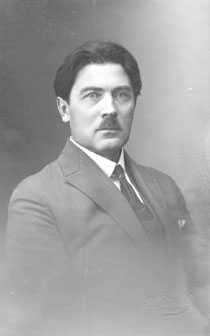Johannes Aavik

Johannes Aavik (8 December [O.S. 26 November] 1880 in Randvere, Laimjala Parish, Saare County – 18 March 1973 in Stockholm) was an Estonian philologist and Fennophile who played a significant role in the modernization and development of the Estonian language.[1]
Education and career
Aavik studied history at the University of Tartu and the University of Nezin in 1905. He was a member of the Young Estonia movement and obtained a Doctorate in Romance languages at the University of Helsinki in 1910. Aavik taught Estonian and French at Tartu University between 1926 to 1933. In 1934 he was appointed by the Estonian Ministry of Education as Chief Inspector of Secondary Schools, a position he held until 1940.[2] He fled Soviet occupation in 1944 and lived in Stockholm for the remainder of his life.
Estonian language development
Johannes Aavik found that Estonian, which had for centuries been the language of peasants, needed innovation, as its sphere of usage widened rapidly with the emergence of a modern nation. There was a need for standardization of grammar and orthography as well as new technical terminology. Aavik added that the language also needed to be versatile and euphonic. In 1912 he started writing articles to literary journals, making propositions how to develop Estonian language. He suggested intensive borrowing from Finnish; many of his suggestions were quickly widely accepted and have become part of standard Estonian vocabulary. From 1914 he started to artificially create well sounding new word stems to replace awkward compound words. Thus he proposed relv (’weapon’) instead of sõjariist (literally ’war tool’), roim (’crime’) instead of kuritöö (’evil deed’) and veenma (’convince’) instead of uskuma panema (’make believe’). He generally tried to avoid the sounds t and s and preferred shorter words to longer ones. He also favoured o in successive syllables to u, as is common in the South Estonian dialects.
Aavik tried to modernize even the grammar. He advocated the usage of i-plural instead of t(d)-plural (keelis pro keeltes) and the i-superlative instead of the ordinary superlative (suurim pro kõige suurem), as well as –nd instead of –nud in active past participle. He proposed inflexional affixes to the ma-infinitive, but only some of them entered into popular usage. He also tried to introduce a future form of verbs and a female personal pronoun, but these got little positive response.
Aavik published numerous essays and translations to propagate his ideas; he had vocal supporters as well as opponents. In 1919, he published a dictionary of 2000 novelty words. His principles (utility, aesthetics and native quality) were summarized in "Keeleuuenduse äärmised võimalused" (Extreme Perspectives of Language Innovation; Tartu, 1924).
Language innovation slowly died away after the 1927 act that made it compulsory for schools to teach standard Estonian as put down in Estonian Orthographic Dictionary (1925, chief editor J. V. Veski) and Estonian Grammar (by Elmar Muuk, 1927). However, some words proposed by Aavik and fallen into oblivion have been picked up and re-introduced by more recent literati.
An essay on linguistic innovation in Estonian by Paul Saagpakk can be found in his Estonian-English Dictionary.
References
- ↑ Toivo Miljan, Historical Dictionary of Estonia, Scarecrow Press 2004
- ↑ The International Who's Who 1943-44. 8th edition. George Allen & Unwin, London, 1943, p. 1.
Further reading
- Antoine Chalvin. Johannes Aavik et la rénovation de la langue estonienne. Paris: ADEFO/L'Harmattan, 2010. 334 p.
- Virve Raag. The Effects of Planned Change on Estonian Morphology. Acta Universitatis Upsaliensis, Studia Uralica Upsaliensia, 29. Uppsala, 1998. 156 p.
|